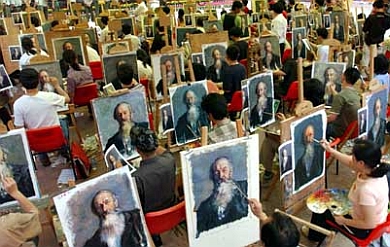Original Hyper Fake Reproductions
The fluid reality that spans the territory between the real and the fake, between simulations and the hyperreal, between the authentic and counterfeit, is the slippery territory where we all now live. This blurred continent is Philip K. Dick’s universe, and the land of reality TV, and the home of pirates. There is something deeply disturbing about our inability to tell real from unreal (who can discern a fake diamond from real?), or to care about it. As the post-modernists maintain, sometimes the fake is so real, it becomes realer than real (hyperreal) and we come to prefer it.
I have a similar preference for fake paintings. I can prefer the fake versions of famous paintings, in part because they are re-visioned. In China there is an entire village given over to making money by fake paintings. These are not counterfeits intended to deceive. No one is fooled into thinking the Van Gogh painting they just bought is painted by Van Gogh. Rather the fake is like a reproduced poster of Van Gogh. But since it has been painted by hand, often with gusto and intelligence, it is much more interesting than a duplication of the original. It is an original reproduction. It is a hyperfake.
Re-painting masters is a venerable activity. Almost all art students are required and encouraged to do this. And most masters of old themselves re-painted their masters’ art. What’s new here is the scale of this re-work, which brings down its cost similar to machine reproduction.

According to the official web site of this counterfeit painting city, called Da Fen Oil Painting Village in Buji, Longgang, Shenzhen, there are currently 622 galleries and over 5,000 artists at work there. While a lot of the paintings for sale are copies of masters, there are also copies of junk, and attempts at originality. But where else can you get a passable Rembrant for $50?


